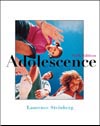| Major Section | Study Guide Features |
| I. Changes in Cognition | Learning Objectives: 1 |
| | Important terms: cognition |
| | |
| A. Thinking about possibilities | Important terms: hypothetical thinking, |
| | inductive reasoning, deductive reasoning Multiple choice questions: 1-3 |
| | |
| B. Thinking about abstract concepts | Important terms: abstract concepts |
| | Multiple choice questions: 4 Matching questions: 20 |
| | |
| C. Thinking about thinking | Learning Objectives: 2 |
| | Important terms: metacognition, adolescent egocentrism, imaginary audience, personal fable Multiple choice questions: 5, 7, 8 Fill in the blank questions: 1 Matching questions: 1, 2, 9 |
| | |
| D. Thinking in multiple dimensions | Learning Objectives: 3 |
| | Important terms: multidimensional thinking Multiple choice questions: 9-10 Fill in the blank questions: 2 |
| | |
| E. Adolescent relativism | Important terms: relativistic thinking |
| | Multiple choice questions: 11 |
| | |
| II. Theoretical Perspectives on | |
| Adolescent Thinking | |
| | |
| A. The Piagetian view of adolescent thinking | |
| | |
| 1. The growth of formal-operational thinking | Learning Objectives: 4 |
| | Important terms: Piagetian perspective, cognitive-developmental view, sensorimotor stage, preoperational stage, concrete operations, formal operations, propositional logic, emergent formal operations Multiple choice questions: 12 Fill in the blank questions: 3-6 Matching questions: 3, 4, 8 |
| | |
| 2. The scientific study of adolescence: | Important terms: |
| Separating competence and performance | competence-performance distinction |
| in studies of adolescent reasoning | |
| | |
| B. The information-processing (I-P) view | Learning Objectives: 5 |
| of adolescent thinking | Important terms: information-processing |
| | perspective Multiple choice questions: 16 Fill in the blank questions: 7 |
| | |
| 1. Changes in information-processing | Important terms: selective attention, divided |
| abilities during adolescence | attention, working memory, long-term |
| | memory, processing speed, organizational strategies Multiple choice questions: 24, 26 Fill in the blank questions: 9-10 Matching questions: 10-11 |
| | |
| C. New directions for theories about | Important terms: Robbie Case, |
| adolescent thinking | automatization, heuristic thinking |
| | Multiple choice questions: 27 |
| | |
| D. The adolescent brain | Learning Objectives: 6 |
| | functional magnetic resonance imaging, positron emission tomography, cortex, limbic system, myelination, pruning, neurotransmitters, prefrontal cortex Multiple choice questions: 6, 13, 17, 18, 21 Fill in the blank questions: 11-13 Matching questions: 7 |
| | |
| III. Individual Differences in Intelligence | Learning Objectives: 7 |
| in Adolescence | |
| | |
| A. Measuring intelligence | Important terms: intelligence test, |
| | Alfred Binet Fill in the blank questions: 14 |
| | |
| 1. The IQ test | Important terms: cohort |
| | Multiple choice questions: 28, 32 Fill in the blank questions: 15-16 |
| | |
| 2. Sternberg's Triarchic Theory | Important terms: triarchic theory of |
| | intelligence, Robert Sternberg Multiple choice questions: 25 Fill in the blank questions: 18 Matching questions: 14 |
| | |
| 3. Gardner's Theory of Multiple | Important terms: Howard Gardner, multiple |
| Intelligences | intelligences |
| | Fill in the blank questions: 17 Matching questions: 12 |
| | |
| B. Intelligence: Test performance in adolescence | |
| | |
| 1. The SAT | Important terms: SAT |
| | Multiple choice questions: 19 Matching questions: 6 |
| | |
| a. The sexes: Are there differences in | Multiple choice questions: 29 |
| mental abilities at adolescence (anymore)? | |
| | |
| C. Culture and intelligence | Learning Objectives: 8 |
| | Important terms: Lev Vygotsky, zone of proximal development, scaffolding, culture-fair tests Multiple choice questions: 30-31 Fill in the blank questions: 19 Matching questions: 5, 17 |
| | |
| IV. Adolescent Thinking in Context | |
| | |
| A. Changes in social cognition | Learning Objectives: 9 |
| | Important terms: social cognition Multiple choice questions: 33 |
| | |
| 1. Impression formation | Important terms: impression formation, |
| | implicit personality theory Matching questions: 16, 18 |
| | |
| 2. Social perspective taking | Important terms: social perspective taking, |
| | mutual role taking Multiple choice questions: 20 Fill in the blank questions: 20 |
| | |
| 3. Conceptions of morality and social convention | Important terms: morality, social |
| | conventions |
| | |
| B. Adolescent risk taking | Learning Objectives: 10 |
| | Important terms: risk taking behavior, behavioral decision theory, sensation seeking Multiple choice questions: 22, 34 Matching questions: 13, 15 |
| | |
| C. Adolescent thinking in the classroom | Important terms: critical thinking, emergent |
| | formal operations Multiple choice questions: 23, 35 Matching questions: 19 |



 2002 McGraw-Hill Higher Education
2002 McGraw-Hill Higher Education